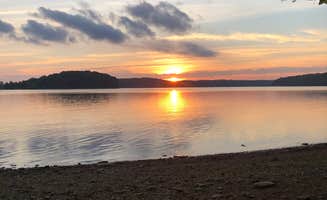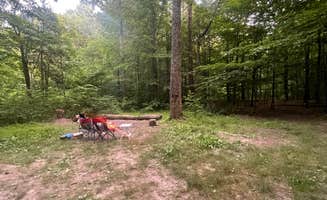Dispersed camping near Shoals, Indiana offers primitive backcountry sites throughout Hoosier National Forest at elevations ranging from 500 to 900 feet. The region experiences hot, humid summers and cold winters with occasional snowfall, making spring and fall the most comfortable camping seasons. Several camping areas remain accessible year-round, though road conditions deteriorate significantly during wet periods.
What to do
Stargazing in open areas: The limited light pollution at Sundance Lake Dispersed Camping creates excellent night sky viewing opportunities. One camper noted, "Free disbursed camping at its best in Indiana. Not another soul camped within earshot," providing the solitude needed for proper stargazing.
Hiking nearby trails: Several trails connect to camping areas throughout the forest. At Peninsula Trail, campers have direct access to hiking paths of varying difficulty. "The Peninsula Trail and Grub Ridge trails both have marked campsites that are very far apart and totally private," reports one visitor, with another adding it was "an awesome backpacking journey for starters, little bit rough because of the horse riding track."
Fishing opportunities: Many dispersed sites provide access to creeks and lakes for fishing. At Sundance Lake, anglers can fish directly from shore. "Small lake nearby with what looks like some trails," mentions one camper, though success rates vary seasonally.
Wildlife observation: Early mornings offer the best wildlife viewing opportunities. "Went there with my kids and wife... Springs available in the valleys but watch for timber rattlesnakes," advises one Peninsula Trail camper, highlighting both opportunities and precautions.
What campers like
Deep isolation: Many campers specifically praise the seclusion at Berry Ridge Road. One visitor emphasized this aspect: "Beautiful secluded site that is pretty far off of the road, but not too far. There was no traffic or other people in site," while another noted, "Each site is fairly far apart. It's really quite only seen a handful of cars drive by."
Fire rings at established sites: Despite the primitive nature, many sites feature basic fire rings. A Berry Ridge Road camper mentioned: "Multiple campsites in the area, I've stayed at two both of which were away from others, clean, fairly flat and had plenty of dead wood around to burn."
Lake views: Some campsites offer scenic water views. At Peninsula Trail, "Campsite #18 has a great view and is large enough for at least 4 tents if you have a big group," according to one backpacker.
Natural soundscape: The minimal human presence creates a peaceful auditory environment. One Hickory Ridge Primitive Dispersed Campsites visitor commented on the quiet: "Very secluded, I got there in a sedan in the winter and i was able to safely find my way. Very nice drive during the day, hiking is fantastic!"
What you should know
Vehicle clearance requirements: Many roads demand vehicles with higher clearance. At Horse Camp Rd Dispersed, access can be challenging after rain. A Mitchell Creek Road camper advised, "I did not see any pull offs that would accommodate an RV of any size, and nothing large enough to turn a trailer around."
Limited cell reception: Communication options vary widely by location. "Have a paper map handy, as there is no cell signal and GPS was spotty," warned one Mitchell Creek visitor, while another Berry Ridge camper reported "good reception" at their site.
Seasonal changes: Weather dramatically affects accessibility and comfort. One Hickory Ridge visitor pointed out, "I pulled in at midnight in a sedan in the winter and i was able to safely find my way," showing winter access is possible on some roads.
Site availability patterns: Weekends see significantly higher usage. A Sundance Lake camper observed, "On the weekends, the activity picked up with a lot of partying and hunting," contrasting with quieter weekday periods.
Time limits: Forest regulations limit stays. "14 day limit. No reservations needed or available. Just show up and camp if a site is open," explained a Sundance Lake camper.
Tips for camping with families
Choose established sites: For family camping, look for more developed dispersed sites. One Mitchell Creek Road Dispersed camper advised, "This is NOT a campground, but just roadside pull-offs on public land. There are no restrooms, fire rings, picnic tables, or other amenities," which helps set proper expectations.
Wildlife safety education: Teach children about local wildlife before arrival. A Peninsula Trail visitor shared, "Went there with my kids and wife, we had a really great time. Primitive camping at its finest," but also warned to "watch for timber rattlesnakes" in valley areas.
Pack plenty of water: No reliable water sources exist at most sites. "Long walk to the water so make sure you bring plenty of drinking water," recommended a family who visited Peninsula Trail.
Consider bathroom arrangements: Without facilities, families need a plan. One Berry Ridge camper emphasized understanding what dispersed camping means: "For those of you who don't understand disperse camping this is the perfect site for a tent to camp without anything but what you bring in and take out."
Tips for RVers
Size limitations: Most dispersed sites cannot accommodate larger vehicles. A Berry Ridge visitor noted, "Some sites, at least one, could fit a pretty good sized camper," but these are exceptions rather than the rule.
Turnaround challenges: Plan for limited maneuvering space. A Mitchell Creek Road camper warned, "One pull off was nearly too small to turn around my small pick up truck," highlighting the tight spaces even for modest vehicles.
Weather-dependent access: Rain significantly reduces accessibility for RVs. A camper at Berry Ridge mentioned, "Not very big, I would not bring a Rv here especially after rain," indicating the seasonal limitations.
Leveling preparation: Sites rarely offer level parking. A visitor with a "promaster conversion" at Berry Ridge noted they "had no trouble making it to this site, however the road was gravel and steep at times," suggesting smaller conversion vans may navigate better than traditional RVs.



